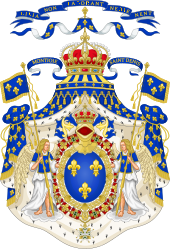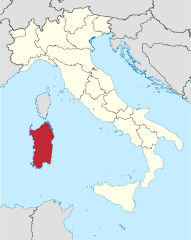Feel free to add any term you like to be authomaticaly linked throughout all the website.
Currently sorted By creation date ascending Sort chronologically: By last update | By creation date

House of Bourbon:The House of Bourbon is a European royal house of French origin, a branch of the Capetian dynasty. Bourbon kings first ruled Navarre and France in the 16th century. By the 18th century, members of the Bourbon dynasty also held thrones in Spain, Naples, Sicily, and Parma. Spain and Luxembourg currently have Bourbon monarchs.  Bourbon monarchs ruled Navarre (from 1555) and France (from 1589) until the 1792 overthrow of the monarchy during the French Revolution. Restored briefly in 1814 and definitively in 1815 after the fall of the First French Empire, the senior line of the Bourbons was finally overthrown in the July Revolution of 1830. A cadet branch, the House of Orl?ans, then ruled for 18 years (1830?1848), until it too was overthrown. The Princes of Cond? were a cadet branch of the dukes of Vend?mes and, in turn, were senior to the Princes of Conti both of which are now extinct. Philip V of Spain was the first Bourbon of Spain. The Spanish Bourbons (in Spanish, the name is spelled Borb?n) have been overthrown and restored several times, reigning 1700?1808, 1813?1868, 1875?1931, and 1975 to the present day. From this Spanish line comes the royal line of the Kingdom of the Two Sicilies (1734?1806 and 1815?1860, and Sicily only in 1806?1816), the Bourbon of the Two Sicilies family, and the Bourbon rulers of the Duchy of Parma. Grand Duchess Charlotte of Luxembourg married a cadet of the Parmese line and thus her successors, who have ruled Luxembourg since her abdication in 1964, have also been members of the House of Bourbon. Isabel, Princess Imperial, the declared heiress and thrice-regent of the now-defunct Empire of Brazil, married twenty years before their deposition Prince Gaston, Count of Eu, their descendants, known as the Orl?ans and Braganza, would have ascended to that throne had the empire not ended in 1889. From the time of Hugh Capet to Charles X (987?1830), the senior Capets were also the Kings of France. In 1589, Henry IV of France, head of the House of Bourbon, became the senior Capet, following the extinction of male line of the House of Valois. All members of the House of Bourbon and its cadet branches alive today are direct agnatic descendants of Henry IV. (source: Wikipedia) | |
|
Caprera:Caprera is a small island off the coast of Sardinia, Italy, located in the Maddalena archipelago. Caprera, Italy (See a bigger map) In the area of La Maddalena island in the Strait of Bonifacio, it is a tourist destination and is famous as the place to which Giuseppe Garibaldi retired (1856?82). This island has been declared a natural reserve for the particular species of seabirds living on it (royal seagull, cormorant and peregrine falcon). The island's name is linked to that of Giuseppe Garibaldi, an Italian patriot and fighter who lived in the 19th century and was one of the fathers of the Italian independence. He bought the island in 1855 and died there in 1882. His house is now a museum and a memorial chapel and the island itself is a national monument. Caprera is linked to La Maddalena island by a 600 metre long causeway. The island was probably given its name because of the numerous wild goats living on it (capra means "goat" in Italian). It is the second largest island in the archipelago and has a surface of 15.7 km² and 45 kilometres of coastline. Monte Tejalone is the highest point (212 m). On the south-western side there is a very important sailing centre and the many coves and anchorages which can be found along the coastline make the landing easy. Many remains of Roman cargo ships as well as of the boat of Garibaldi were found there. After the Roman occupation, Caprera remained deserted for centuries before being inhabited by groups of shepherds. Later in 1855 Garibaldi decided to settle there and planted the first trees of the blooming pinewood which covers the island today. A century after Garibaldi's death the island was freed from the numerous existing military restrictions and is now completely open to the public. (source: Wikipedia) |
Sardinia:Sardinia (Italian: Sardegna, Sardinian: Sardigna) is the second largest island in the Mediterranean Sea (after Sicily and before Cyprus) and an autonomous region of Italy. The nearest land masses are (clockwise from north) the island of Corsica, the Italian Peninsula, Sicily, Tunisia and the Balearic Islands.  (source: Wikipedia) | |
|
Allegory:Allegory is a device in which characters or events represent or symbolize ideas and concepts. Allegory has been used widely throughout the history of art, and in all forms of artwork. A reason for this is that allegory has an immense power of illustrating complex ideas and concepts in a digestible, concrete way. In allegory a message is communicated by means of symbolic figures, actions or symbolic representation. Allegory is generally treated as a figure of rhetoric; a rhetorical allegory is a demonstrative form of representation conveying meaning other than the words that are spoken.  Allegory of arithmetic, by Laurent de La Hyre, ca 1650 As a literary device, an allegory in its most general sense is an extended metaphor. One of the best known examples is Plato's "The Allegory of the Cave." In this allegory, there are a group of people who have lived chained to the wall of a cave all of their lives, facing a blank wall. The people watch shadows projected on the wall by things passing in front of a fire behind them, and begin to ascribe forms to these shadows. According to the allegory, the shadows are as close as the prisoners get to viewing reality. (source: Wikipedia) |
Symbolism:Symbolism is the practice of representing things by symbols, or of investing things with a symbolic meaning or character. A symbol is an object, action, or idea that represents something other than itself, often of a more abstract nature. Symbolism creates quality aspects that make literature like poetry and novels more meaningful. (source: Wikipedia) | |
|
Metaphor:A metaphor is a literary figure of speech that describes a subject by asserting that it is, on some point of comparison, the same as another otherwise unrelated object. Metaphor is a type of analogy and is closely related to other rhetorical figures of speech that achieve their effects via association, comparison or resemblance including allegory, hyperbole, and simile. One of the most prominent examples of a metaphor in English literature is the All the world's a stage monologue from As You Like It:
This quote is a metaphor because the world is not literally a stage. By figuratively asserting that the world is a stage, Shakespeare uses the points of comparison between the world and a stage to convey an understanding about the mechanics of the world and the lives of the people within it. | |
|
Jos? Lu?s Peixoto:Jos? Lu?s Peixoto (born 4 September 1974, in Galveias, Portalegre, Portugal), is a Portuguese writer who has written fiction, poetry, drama, lyrics and has participated in a wide number of projects involving writing.  (source: Wikipedia) | |
|
Orhan Pamuk:Ferit Orhan Pamuk (generally known simply as Orhan Pamuk; born 7 June 1952) is a Turkish novelist, screenwriter, academic and recipient of the 2006 Nobel Prize in Literature. One of Turkey's most prominent novelists, his work has sold over eleven million books in sixty languages, making him the country's best-selling writer.  Orhan Pamuk in 2008 Born in Istanbul, Pamuk is Robert Yik-Fong Tam Professor in the Humanities at Columbia University, where he teaches comparative literature and writing. His novels include The White Castle, The Black Book, The New Life, My Name Is Red and Snow. As well as the Nobel Prize in Literature (the first Nobel Prize to be awarded to a Turkish citizen), Pamuk is the recipient of numerous other literary awards. My Name Is Red won the 2002 Prix du Meilleur Livre ?tranger, 2002 Premio Grinzane Cavour and 2003 International IMPAC Dublin Literary Award. The European Writers' Parliament came about as a result of a joint proposal by Pamuk and Jos? Saramago. In 2005, Pamuk was put on trial in Turkey after he made a statement regarding the Armenian Genocide and mass killing of Kurds in the Ottoman Empire. His intention, according to Pamuk himself, had been to highlight issues relating to freedom of speech (or lack thereof) in the country of his birth. The ensuing controversy featured the burning of Pamuk's books at rallies. He has also been the target of assassination attempts. (source: Wikipedia) | |
|
Snow:Snow (Turkish: Kar) is a novel by Turkish author Orhan Pamuk. It was published in Turkish in 2002 and in English (translated by Maureen Freely) in 2004. The story encapsulates many of the political and cultural tensions of modern Turkey and successfully combines humor, social commentary, mysticism, and a deep sympathy with its characters.  Kar is the word for Snow, but the main character also abbreviates his name to Ka (his initials) with the novel set in the eastern Turkish city of Kars. An opening (and recurring) theme concerns reasons behind a suicide epidemic among teenage girls (which actually took place in the city of Batman). (source: Wikipedia) | |
|
Feminism:Feminism is a collection of movements and ideologies aimed at defining, establishing, and defending equal political, economic, and social rights for women. This includes seeking to establish equal opportunities for women in education and employment. A feminist is "an advocate or supporter of the rights and equality of women". (source: Wikipedia) | |
|
